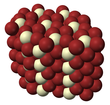| |||
| Names | |||
|---|---|---|---|
| IUPAC names
Cerium(III) bromide Cerium tribromide | |||
| Other names Cerous bromide | |||
| Identifiers | |||
| CAS Number | |||
| 3D model (JSmol) | |||
| ChemSpider | |||
| ECHA InfoCard | 100.034.936 | ||
| EC Number |
| ||
| PubChem CID | |||
| UNII | |||
| CompTox Dashboard (EPA) | |||
InChI
| |||
SMILES
| |||
| Properties | |||
| Chemical formula | CeBr3 | ||
| Molar mass | 379.828 g/mol | ||
| Appearance | grey to white solid, hygroscopic | ||
| Density | 5.1 g/cm, solid | ||
| Melting point | 722 °C (1,332 °F; 995 K) | ||
| Boiling point | 1,457 °C (2,655 °F; 1,730 K) | ||
| Solubility in water | 4.56 mol kg (153.8 g/100 g) | ||
| Structure | |||
| Crystal structure | hexagonal (UCl3 type), hP8 | ||
| Space group | P63/m, No. 176 | ||
| Coordination geometry | Tricapped trigonal prismatic (nine-coordinate) | ||
| Hazards | |||
| GHS labelling: | |||
| Pictograms | 
| ||
| Signal word | Warning | ||
| Hazard statements | H315, H319, H335 | ||
| Flash point | Non-flammable | ||
| Related compounds | |||
| Other anions | Cerium(III) fluoride Cerium(III) chloride Cerium(III) iodide | ||
| Other cations | Lanthanum(III) bromide Praseodymium(III) bromide | ||
| Except where otherwise noted, data are given for materials in their standard state (at 25 °C , 100 kPa).
| |||
Cerium(III) bromide is an inorganic compound with the formula CeBr3. This white hygroscopic solid is of interest as a component of scintillation counters.
Preparation and basic properties
The compound has been known since at least 1899, when Muthman and Stützel reported its preparation from cerium sulfide and gaseous HBr. Aqueous solutions of CeBr3 can be prepared from the reaction of Ce2(CO3)3·H2O with HBr. The product, CeBr3·H2O can be dehydrated by heating with NH4Br followed by sublimation of residual NH4Br. CeBr3 can be distilled at reduced pressure (~ 0.1 Pa) in a quartz ampoule at 875-880 °C. Like the related salt CeCl3, the bromide absorbs water on exposure to moist air. The compound melts congruently at 722 °C, and well ordered single crystals may be produced using standard crystal growth methods like Bridgman or Czochralski.
CeBr3 adopts the hexagonal, UCl3-type crystal structure with the P63/m space group. The cerium ions are 9-coordinate and adopt a tricapped trigonal prismatic geometry. The cerium–bromine bond lengths are 3.11 Å and 3.16 Å.
Applications
CeBr3-doped lanthanum bromide single crystals are known to exhibit superior scintillation properties for applications in the security, medical imaging, and geophysics detectors.
Undoped single crystals of CeBr3 have shown promise as a γ-ray scintillation detector in nuclear non-proliferation testing, medical imaging, environmental remediation, and oil exploration.
Suppliers
References
- Mioduski, Tomasz; Gumiński, Cezary; Zeng, Dewen; Voigt, Heidelore (2013). "IUPAC-NIST Solubility Data Series. 94. Rare Earth Metal Iodides and Bromides in Water and Aqueous Systems. Part 2. Bromides". Journal of Physical and Chemical Reference Data. 42 (1). AIP Publishing: 013101. Bibcode:2013JPCRD..42a3101M. doi:10.1063/1.4766752. ISSN 0047-2689.
- Muthmann, W.; Stützel, L. (1899). "Eine einfache Methode zur Darstellung der Schwefel-, Chlor- und Brom-Verbindungen der Ceritmetalle". Berichte der Deutschen Chemischen Gesellschaft (in German). 32 (3). Wiley: 3413–3419. doi:10.1002/cber.189903203115. ISSN 0365-9496.
- Rycerz, L.; Ingier-Stocka, E.; Berkani, M.; Gaune-Escard, M. (2007). "Thermodynamic Functions of Congruently Melting Compounds Formed in the CeBr3−KBr Binary System". Journal of Chemical & Engineering Data. 52 (4). American Chemical Society (ACS): 1209–1212. doi:10.1021/je600517u. ISSN 0021-9568.
- Morosin, B. (1968). "Crystal Structures of Anhydrous Rare-Earth Chlorides". The Journal of Chemical Physics. 49 (7). AIP Publishing: 3007–3012. Bibcode:1968JChPh..49.3007M. doi:10.1063/1.1670543. ISSN 0021-9606.
- Wells, A. F. (1984). Structural Inorganic Chemistry (5th ed.). Oxford University Press. p. 421. ISBN 978-0-19-965763-6.
- Greenwood, Norman N.; Earnshaw, Alan (1997). Chemistry of the Elements (2nd ed.). Butterworth-Heinemann. pp. 1240–1241. ISBN 978-0-08-037941-8.
- Zachariasen, W. H. (1948). "Crystal chemical studies of the 5f-series of elements. I. New structure types". Acta Crystallogr. 1 (5): 265–268. Bibcode:1948AcCry...1..265Z. doi:10.1107/S0365110X48000703.
- van Loef, E. V. D.; Dorenbos, P.; van Eijk, C. W. E.; Krämer, K.; Güdel, H. U. (2001-09-03). "High-energy-resolution scintillator: Ce activated LaBr3". Applied Physics Letters. 79 (10). AIP Publishing: 1573–1575. Bibcode:2001ApPhL..79.1573V. doi:10.1063/1.1385342. ISSN 0003-6951.
- Menge, Peter R.; Gautier, G.; Iltis, A.; Rozsa, C.; Solovyev, V. (2007). "Performance of large lanthanum bromide scintillators". Nuclear Instruments and Methods in Physics Research Section A: Accelerators, Spectrometers, Detectors and Associated Equipment. 579 (1). Elsevier BV: 6–10. Bibcode:2007NIMPA.579....6M. doi:10.1016/j.nima.2007.04.002. ISSN 0168-9002.
- Higgins, W.M.; Churilov, A.; van Loef, E.; Glodo, J.; Squillante, M.; Shah, K. (2008). "Crystal growth of large diameter LaBr3:Ce and CeBr3". Journal of Crystal Growth. 310 (7–9). Elsevier BV: 2085–2089. Bibcode:2008JCrGr.310.2085H. doi:10.1016/j.jcrysgro.2007.12.041. ISSN 0022-0248.
| Cerium compounds | |||
|---|---|---|---|
| Cerium(II) | |||
| Cerium(III) |
| ||
| Cerium(III,IV) | |||
| Cerium(IV) | |||
| Salts and covalent derivatives of the bromide ion | ||||||||||||||||||||||||||||||||||||||||||||||||||||||||||||||||||||||||||||||||||||||||||||||||||||||||||||||||||||||||||||||||||||||||||||||||||||||||||||||||||||
|---|---|---|---|---|---|---|---|---|---|---|---|---|---|---|---|---|---|---|---|---|---|---|---|---|---|---|---|---|---|---|---|---|---|---|---|---|---|---|---|---|---|---|---|---|---|---|---|---|---|---|---|---|---|---|---|---|---|---|---|---|---|---|---|---|---|---|---|---|---|---|---|---|---|---|---|---|---|---|---|---|---|---|---|---|---|---|---|---|---|---|---|---|---|---|---|---|---|---|---|---|---|---|---|---|---|---|---|---|---|---|---|---|---|---|---|---|---|---|---|---|---|---|---|---|---|---|---|---|---|---|---|---|---|---|---|---|---|---|---|---|---|---|---|---|---|---|---|---|---|---|---|---|---|---|---|---|---|---|---|---|---|---|---|---|
| ||||||||||||||||||||||||||||||||||||||||||||||||||||||||||||||||||||||||||||||||||||||||||||||||||||||||||||||||||||||||||||||||||||||||||||||||||||||||||||||||||||

